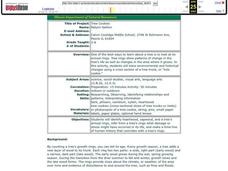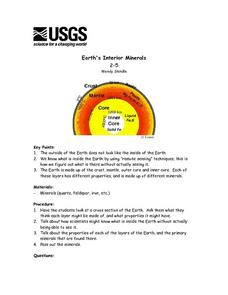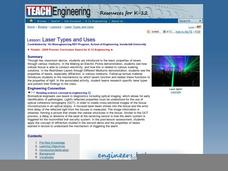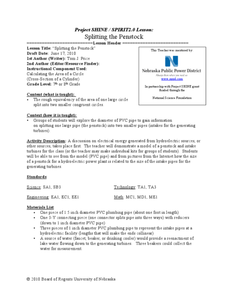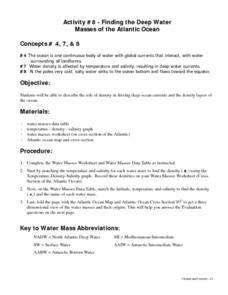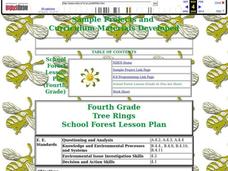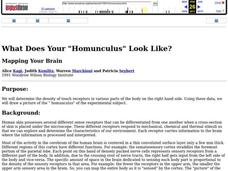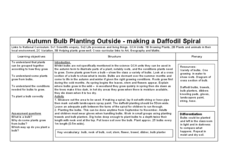Curated OER
Layers of Rock
Juvenile geologists drill clear plastic straws down into a playdough sedimentary rock model, pulling out sample rock cores. As they analyze their cores, they apply the law of superposition and discover that originally horizontal layers...
Statistics Education Web
It Creeps. It Crawls. Watch Out For The Blob!
How do you find the area of an irregular shape? Class members calculate the area of an irregular shape by finding the area of a random sampling of the shape. Individuals then utilize a confidence interval to improve accuracy and use a...
EngageNY
Modeling Riverbeds with Polynomials (part 2)
Examine the power of technology while modeling with polynomial functions. Using the website wolfram alpha, learners develop a polynomial function to model the shape of a riverbed. Ultimately, they determine the flow rate through the river.
Curated OER
Becoming Part of the Community
High schoolers identify how various cultures are similiar. As a class, they read an essay of a Peace Corps volunteer being integrated into their new community. In groups, they take the elements from the story and put them into different...
Curated OER
Poly-Mania
This hands-on lesson plan takes young geometers on a tour of 2D polygons and 3D polyhedrons. After exploring different web resources and discussing geometric shapes, small groups construct models of polyhedrons using bendable straws....
EngageNY
Unknown Length and Area Problems
What is an annulus? Pupils first learn about how to create an annulus, then consider how to find the area of such shapes. They then complete a problem set on arc length and areas of sectors.
NOAA
Sediments
Calcareous ooze ... what an interesting name! The 15th installment of a 23-part NOAA Enrichment in Marine sciences and Oceanography (NEMO) program focuses on sediments found on the ocean floor. After viewing the slideshow lecture,...
Cornell University
Beam Focusing Using Lenses
Explore optics using an inquiry-based experimental approach! Young scholars use a set of materials to design and build a unit capable of focusing a beam of light. They experiment with different lenses to determine the best approach to...
Chemistry Collective
Osmotic Pressure: Spontaneous Balloon Popping
Visualize osmosis using an interactive activity. As learners monitor a simulation, they witness the particle movement through the membrane. A balloon represents the cellular membrane and 'pops' as osmosis creates an imbalance of particles.
Curated OER
Tree Cookies
Students identify heartwood, sapwood, and a tree's annual rings, infer from a tree's rings what damage or stress might have occurred in its life, and make a time-line of human history that coincides with a tree's rings.
Curated OER
Earth's Interior Minerals
Pupils identify the layers of the Earth. They discover the properties and minerals in each layer. They answer questions about the minerals found to end the lesson.
Curated OER
Testing the Accuracy of a Rain Gauge
Young scholars identify and test variables that may affect the accuracy of a rain gauge. They share findings of their research with the class in a 'mini-meteorology-convention'. They design an experiment with a control setup to test...
Curated OER
Laser Types and Uses
Students examine the properties of lasers and research their types and uses. In this laser instructional activity students view several demonstrations.
Curated OER
Splitting the Penstock
Students investigate the best way to calculate the measurements of an area. In this geometry lesson plan, students relate a large circle to a cylinder and its measurements. They use PVC pipes to gain hands on experience as they calculate...
Curated OER
Finding the Deep Water Masses of the Atlantic Ocean
Learners describe the role of density in driving deep ocean currents and the density layers of the ocean. They determine that the ocean is one continuous body of water with global currents that interact, with water surrounding all...
Curated OER
Fossil Fuels (Part II), The Geology of Oil: Topographic Mapping, Crustal Deformation, Rock Porosity, and Environmental Pollution
Learners review an interpretation of geologic history and relate it to the formation of oil deposits. They explore and explain factors controlling the porosity and permeability of sediments and sedimentary rocks. Pupils also interpret...
Curated OER
Stream Study
Students study the characteristics of a stream habitat. In this life science lesson, students use sieves, nets, and jars to collect aquatic organisms. Students also measure the temperature of the stream and calculate the speed of the...
Curated OER
Fossil Fuels (III), The Geology of Coal: Interpreting Geologic History
Learners hypothesize about why various samples of coal have different characteristics. Pupils use information that they found during Internet searches to ascertain the validity of their hypotheses and verify the "story" of coal. ...
Curated OER
Tree Rings
Fourth graders explore tree rings. In this plant biology lesson, 4th graders construct a KWL chart on tree rings and examine real tree rings. Students identify the changes that happened during the tree's life and its actual age. Students...
Curated OER
CUPCAKE CORE SAMPLING
Young scholars explore what is beneath the surface of the earth is one of the jobs of a geologist. Rather than digging up vast tracts of land to expose an oil field, or to find coalbearing strata, core samples can be taken.
Curated OER
What Does Your "Homunculus" Look Like?
Students investigate the density of touch receptors in various parts of the body. They discover how the body senses various stimuli, then maps a picture of the "homunculus" of the experimental subject.
Curated OER
Autumn Bulb Planting Outside - Making a Daffodil Spiral
Students plant daffodil bulbs. In this gardening activity, students work outside to plant daffodil bulbs in the autumn so that they can grow roots and emerge by spring.
Curated OER
Deducing Induction
High schoolers examine how changing magnetic fields induce currents in
loops and coils, determine orientation and magnitude of magnetic field,
describe Michael Faraday's experiments that led to conclusion that changing
magnetic force...
Curated OER
Anatomy of Living Bone
Students analyze and examine the anatomy of bones and bone conditions. In this bone anatomy lesson, students analyze and examine the structural properties of bones. They explain the relationship between osteoblasts and osteoclasts and...
Other popular searches
- Leaf Diagram Cross Section
- Geological Cross Section
- Cross Section Diagrams
- Cross Section Diagrams
- Bone Cross Section
- Cross Sections of Solids
- Tree Cross Section
- Cross Section Shape
- Pine Tree Cross Section
- Cross Section of Manhattan
- Geologic Cross Section
- Geographic Cross Section











